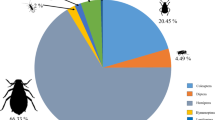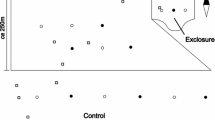Summary
Various ecological characteristics have been determined for the exopterygote insect fauna of three sites in a secondary succession, with successional ages zero–two years (ruderal and early successional — Young Field), seven to eight years (mid successional — Old Field) and around 60 years (late successional — Woodland). The taxonomic diversity of the group as a whole (Table 1) and the trophic diversity (major types of feeding habits) (Table 2) increased with successional age. A comparison of the numbers of individuals and species of insect with the abundance and species of plant of each of the main life forms (annuals, biennials, perennials, trees, grasses (and rushes), ferns and lower plants) showed that at the start of secondary succession there was a good correlation between the number of species of insect and number of species of plant. In the second year and later the correlation is between plant abundance and insect abundance (the number of individuals) (Table 3). The sap-feeding insects may be divided into three specialised guilds: phloem feeders, xylem feeders and mesophyll feeders. The proportion of species in each guild was similar in all four successional stages (Table 4). Niche breadth (determined from host plant records) in the sap feeding herbivores was inversely related to the successional age of their habitat (Table 6). Herbivore species colonising the stages early in succession had, on average, shorter generation times than those of later stages (Table 7).
Similar content being viewed by others
References
Blackman R (1974) Aphids. Ginn, London Aylesbugy
Brown VK (1982) The phytophagous insect community and its impact on early successional habitats. In Visser JH, Minks AK Proc 5th Symp Insect-Plant Relationships. Pudoc, Wageningen, p 205–213
Brown VK (1982) Size and shape as ecological discriminants in successional communities of Heteroptera. Biol J Linn Soc 18:279–290
Cameron CN (1972) Analysis of insect trophic diversity in two salt marsh communities. Ecology 53:58–73
Clapham AR, Tutin TG, Warburg EF (1962) Flora of the British Isles. University Press, Cambridge
Connell JM (1975) Some mechanisms producing structure in natural communities: a model and evidence from field experiments. In Cody ML, Diamond JM (eds). Ecology and Evolution of Communities. Belknap Press, Cambridge Massachusetts and London, p. 460–490
Diamond JM (1979) Community structure: is it random, or is it shaped by species differences and competition. In Anderson RM, Turner BD, Taylor LR (eds). Population Dynamics. 20th Symp Brit Ecol Soc Blackwell Scientific Publications, Oxford London Edinburgh Melbourne p 165–205
Heatwole H, Levins R (1972) The trophic structure, stability and faunal change during recolonisation. Ecology 53:531–534
Lawton JH, Strong DR (Jr) (1981) Community patterns and competition in folivorous insects. Amer Nat 118:317–338
Margalef R (1968) Perspectives in Ecological Theory. University of Chicago Press, Chicago
Moran VC, Southwood TRE (1982) The guild composition of arthropod communities in trees. J Anim Ecol 51:289–306
Mound LA, Morison GD, Pitkin BR, Palmer JM (1976) Thysanoptera. Handbooks for the Identification of British Insects, Vol 1, part 11. Royal Entomological Society of London
Murdock WW, Evans FC, Peterson CH (1972) Diversity and pattern in plants and insects. Ecology 53:819–829
Nagel HG (1979) Analysis of invertebrate diversity in a mixed prairie ecosystem. J Kans Ent Soc 52:777–786
New TR (1974) Psocoptera. Handbooks for the Identification of British Insects, Vol I, part 7. Royal Entomological Society of London
Odum EP (1969) The strategy of ecosystem development. Science 164:262–270
Pianka ER (1981) Competition and niche theory. In May RM (ed) Theoretical Ecology. Blackwell Scientific Publications, Oxford London Edinburgh Boston Melbourne
Reader PM, Southwood TRE (1981) The relationship between palability to invertebrates and the successional status of a plant. Oecologia 51:271–275
Rex A (1981) Community structure in the deep-sea benthos. Ann Rev Ecol Syst 12:331–353
Root RB (1967) The niche exploitation pattern of the blue-gray gnatcatcher. Ecol Monogr 37:317–350
Schimpf DJ, Henderson JA, Macmahon JA (1980) Some aspects of succession in the spruce-fir forest zone of northern Utah. The Great Basin Naturalist 40:1–26
Schoener TW (1971) Theory of feeding strategies. A Rev Ecol Syst 2:369–404
Simberloff DS (1976) Trophic structure determination and equilibrium in an arthropod community. Ecology 57:395–398
Simberloff DS (1978) Colonisation of islands by insects: immigration, extinction and diversity. In Mound LA, Waloff N. Diversity of Insect Faunas. Symp R Ent Soc Lond 9:139–153
Southwood TRE (1977) Habitat, the templet for ecological strategies? J anim Ecol 46:337–365
Southwood TRE, Brown VK, Reader PM (1980) The relationships of plant and insect diversities in succession. Biol J Linn Soc 12:327–348
Southwood TRE, Brown VK, Reader PM Continuity of vegetation in space and time: a comparison of insect's habitat templet in different successional stages. Res Popul Ecol (In press)
Southwood TRE, Leston D (1959) Land and Water Bugs of the British Isles. Frederick Warne, London New York
Stebins GL (1974) Flowering plants — evolution above the species level. Arnold, London
Stinson CSA, Brown VK Seasonal changes in the architecture of natural plant communities and its relevanceto insect herbivores. (In press)
Tramer E (1975) The regulation plant species diversity on an early successional old-field. Ecology 56:905–914
Witkowski Z (1973) Species diversity, stability and succession. Studies on weevils (Curculionidae, Coleoptera) and their host plants during the succession of mowed meadows under the influence of draining. Bull de l'academie polonaise des Sciences 21:223–228
Witkowski Z (1978) Correlates of stability and diversity in weevil communities. Oecologia 37:85–92
Author information
Authors and Affiliations
Rights and permissions
About this article
Cite this article
Brown, V.K., Southwood, T.R.E. Trophic diversity, niche breadth and generation times of exopterygote insects in a secondary succession. Oecologia 56, 220–225 (1983). https://doi.org/10.1007/BF00379693
Received:
Issue Date:
DOI: https://doi.org/10.1007/BF00379693




